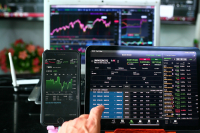Understanding Dynamic Pricing
Dynamic pricing is a strategy employed by brands that constantly changes prices based on various variables. The idea is to offer the same product at different prices points under different circumstances.
Dynamic pricing is a popular strategy in several industries including:
- Ride-Sharing Services
- Tourism
- Sports
- Retail
Businesses use different variables in different industries when implementing a dynamic pricing strategy.
When Should A Business Use Dynamic Pricing?
Even though dynamic pricing is a powerful strategy, it should only be implemented by companies in industries that respond well to rapid changes in pricing.
If pricing is typically fixed in a particular sector, that means that customers are unwilling to pay extra irrespective of conditions. In this case, dynamic pricing can’t work.
Using A Dynamic Strategy
The most effective way of deploying a dynamic pricing strategy is by using rules-based algorithms.
Rules-based tools allow businesses to instantly adjust prices to levels at which customers are willing to pay for an item or service.
For instance, some of the most popular variables used by online retailers to set prices include:
- Competitors’ pricing strategy
- Stock levels and current prices
- Sales of products
Obviously, online retailers lower the prices of products that they have in large quantities while hiking the prices of items that are flying off the shelves.
Different Forms of Dynamic Pricing
Dynamic strategies use various variables to change the prices. Let's go over the most common types of dynamic pricing.
Time-Based Pricing
Companies raise prices faster service - customers are charged extra for same-day delivery.
Time-based pricing is used for products that are in high demand.
Pricing Based On Competitors’ Prices
This pricing tactic relies on competitors’ prices as a basis for making pricing changes.
Companies employ this powerful tactic in the following ways:
- Set prices of items well below those of competitors
- Match prices with competing businesses
- Set prices of items and services well above those of competing companies
These are proven dynamic pricing tactics that allow businesses to remain competitive in a demanding market.
The Benefits of Dynamic Pricing
In the following sections, we discuss the many ways this dynamic pricing can generate both growth and sales.
The Staff Are Rewarded for Hard Work
When demand is strong for products or services offered by a company, then dynamic pricing is able to reward employees for extra work.
Come Up with Attractive Offers
Dynamic pricing allows brands to make promotional offers and generate extra revenue. By lowering prices down during a drop in demand can boost sales of particular items.
Competitive Edge
Businesses can become more competitive by adjusting prices to changing market conditions in real-time. By immediately making pricing corrections, companies can help secure their place in the market.
Selecting the Right Dynamic Pricing Tool
Companies need a pricing software solution that can make price adjustments in response to market demand, inventory levels, etc.
In order to be able to make well-time adjustments businesses need a certain level of automation that algorithms provide. However, writing algorithms is a complicated process that requires both technical expertise.
This is why competitive brands use a business rules engine to enhance their dynamic pricing solutions. Rules engines are software tools that empower non-technical employees to write dynamic pricing rules without help from IT.












